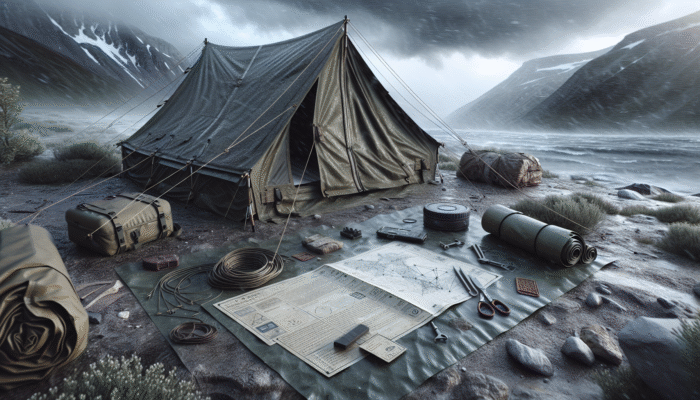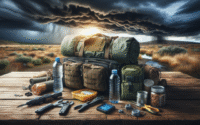English Language Mastery: Tips for Fluent Communication
Essential Gear for S.H.I.T Scenarios: Critical Survival Tools You Can’t Afford to Ignore
When unexpected disasters occur, having the appropriate gear can be the deciding factor between survival and peril. In the realm of emergency preparedness, the essential gear for s.h.i.t scenarios encompasses not just tools but also vital resources that ensure your survival when conventional systems fail. Let’s explore the fundamental components that create a robust survival kit.
Water Purification Systems: Must-Have Solutions for Safe Drinking Water in Emergencies

In any survival situation, water is your most indispensable resource. Without access to safe drinking water, survival becomes increasingly impossible within just a few days. A dependable water purification system should take precedence on your checklist of the essential gear for s.h.i.t scenarios. Portable water filters, UV purifiers, and purification tablets are all excellent tools that convert contaminated water sources into safe drinking options.
Investing in a durable and efficient portable filter, like the LifeStraw or Sawyer Squeeze, enables you to drink directly from natural sources such as lakes, rivers, or even rainwater. These filtration systems effectively eliminate bacteria, parasites, and various harmful contaminants, providing crucial peace of mind in unpredictable environments. Additionally, UV purifiers like the SteriPEN utilize ultraviolet light to kill pathogens, making them a compact, efficient choice for outdoor adventurers.
It’s essential to also include backup options in your survival kit. Purification tablets are lightweight, easy to pack, and capable of treating large volumes of water, ensuring that you’ll never be without access to safe drinking water.
Multi-Tools: Versatile Solutions for a Variety of Emergency Tasks
A multi-tool is an invaluable piece of equipment in your arsenal when facing best gear for s.h.i.t scenarios. These compact devices merge multiple tools into one, maximizing versatility while saving space and weight in your pack. Seek models that incorporate essential functions like pliers, knives, scissors, and screwdrivers.
The Leatherman Wave and Victorinox Swiss Army Knife stand out as top-tier options, known for their durability and multi-functionality. With a quality multi-tool, you can execute a wide range of tasks, from food preparation and repairs to constructing shelters and igniting fires. The convenience of having several tools in a single, compact design is crucial during crises, where every ounce of weight matters.
Moreover, a multi-tool can significantly enhance your efficiency and effectiveness when navigating survival situations. In emergencies, where each second is critical, the ability to swiftly switch between functions without sifting through your gear can be a game-changer.
Emergency Food Rations: Critical Long-Lasting Supplies for Extended Survival
Access to food can quickly dwindle in survival scenarios, making it essential to stock up on emergency food rations. These supplies are designed for longevity, offering vital calories while requiring minimal preparation.
Opt for options like freeze-dried meals from brands such as Mountain House or Wise Company, which boast shelf lives of 25 years or more. These meals are lightweight, easy to prepare—simply add hot water—and provide a balanced nutritional profile. Additionally, energy bars or meal replacement shakes serve as quick, no-cook alternatives to maintain your energy levels.
When strategizing for prolonged survival situations, consider diversifying your food supplies. A mix of savory and sweet rations can help bolster morale during tough times. Remember to include snacks as well; having small comfort foods can provide a much-needed psychological boost when conditions become challenging.
Essential Gear for S.H.I.T Scenarios: Key Equipment for Crisis Preparedness

Being prepared is crucial for navigating any crisis effectively. The best gear for s.h.i.t scenarios should encompass tools that empower you to handle medical emergencies, power outages, and the unpredictable nature of the environment. Below is an in-depth look at essential gear that will elevate your preparedness.
First Aid Kits: Comprehensive Supplies for Treating Injuries and Illnesses in the Field
In emergency situations, injuries can arise unexpectedly. Therefore, having a comprehensive first aid kit is vital. Seek kits that include a wide array of bandages, antiseptics, gauze, and medications such as pain relievers and antihistamines. Brands like Adventure Medical Kits offer diverse options tailored for varying needs, from basic first aid to wilderness-specific kits.
Customize your first aid kit according to your personal needs and the environment you will be traversing. If venturing into remote locations, consider adding specialized items such as a tourniquet or splint. Familiarizing yourself with the contents of your first aid supplies is equally important; ensure you know how to administer basic medical care and routinely check that your kit is fully stocked and up to date.
In high-pressure scenarios, rapid access to first aid can be critical for saving lives. Ensure your kit is easily accessible and consider keeping a smaller, portable version in your everyday carry bag for added convenience.
Portable Power Sources: Solar Chargers and Power Banks for Keeping Essential Devices Functional
In our technology-driven world, the ability to power your devices is more crucial than ever. A reliable portable power source can keep your communication tools operational, which is vital for safety and navigation. The best gear for s.h.i.t scenarios includes solar chargers and power banks that ensure your devices remain charged when traditional power sources are unavailable.
Solar chargers, like those offered by Anker or Goal Zero, are indispensable for extended emergencies. They harness the sun’s energy to charge multiple devices, ensuring you have power even in the most isolated areas. Look for lightweight, foldable models for easy portability.
Power banks are another essential component of your gear. Choose high-capacity models that can recharge your smartphone multiple times. It’s wise to have several charging methods, as electronic devices can quickly drain their batteries during a crisis.
Shelter Solutions: Tents and Tarps for Protection from Harsh Elements

When confronted with the elements, effective shelter solutions become paramount. The best gear for s.h.i.t scenarios should include lightweight tents and tarps that provide shelter from rain, wind, and sun exposure.
A high-quality tent, such as the REI Half Dome or MSR Hubba Hubba, can offer a secure space for rest and recovery. Look for models that are quick to set up, weather-resistant, and spacious enough to accommodate both occupants and gear.
Tarps, by contrast, are incredibly adaptable. They can serve as ground covers, makeshift shelters, or even rain catchment systems. Investing in a robust tarp made from waterproof materials can significantly elevate your survival strategy. Be sure to include the necessary cordage and stakes for securing your shelter effectively.
Essential Gear for S.H.I.T Scenarios: Communication Tools for Staying Connected
During crises, maintaining communication is crucial. The best gear for s.h.i.t scenarios should include devices that enable you to reach out for help or coordinate efforts with others. Here’s a detailed overview of the vital communication tools necessary for survival.
Two-Way Radios: Reliable Communication Devices for Remote Areas
When cellular networks become unreliable, two-way radios become invaluable. They offer a dependable means of communication, especially in remote areas where standard phones may not function. Look for models with an extended range and impressive battery life, such as the Motorola Talkabout series.
Two-way radios are excellent for group settings, allowing teams to maintain contact without incurring costs or relying on cellular services. They can be crucial for coordinating movements, particularly during search and rescue missions.
Before an emergency arises, make sure to practice with your radios, becoming familiar with their features and operating protocols. This preparation can save precious time when immediate communication is necessary.
Satellite Phones: Essential Communication Tools When Traditional Networks Fail
In extreme situations where every minute counts, a satellite phone is often the most reliable option. Unlike standard cell phones, satellite phones can maintain a connection from almost any location on Earth. Brands like Iridium and Inmarsat offer reliable coverage, making them a must-have in your survival gear.
When selecting a satellite phone, consider the coverage area and the associated usage costs. While these devices can be more expensive than traditional phones, the ability to communicate during a crisis justifies the investment.
Be sure to familiarize yourself with the device and keep it charged. Practice using it to ensure you can quickly connect with emergency services or loved ones when necessary.
Signal Mirrors and Whistles: Simple, Yet Effective Tools for Signaling for Help
In many survival scenarios, simplicity proves to be highly effective. Signal mirrors and whistles represent two of the most efficient signaling devices you can carry. These compact tools can attract attention during emergencies, even from great distances.
A signal mirror can reflect sunlight and be visible from miles away, while a whistle can carry sound over long distances, even amidst strong winds or noise. Both are lightweight and easy to store, making them essential components of your survival kit.
Before a crisis occurs, practice using these signaling devices so that you know how to effectively draw attention. Being able to signal for help can mean the difference between rescue and prolonged isolation.
Essential Gear for S.H.I.T Scenarios: Navigation Tools to Find Your Way
In an emergency, understanding your location and knowing how to reach your destination is vital. The best gear for s.h.i.t scenarios includes navigation tools that can guide you through unfamiliar terrain. Here’s an overview of indispensable navigation gear.
GPS Devices: Advanced Solutions for Precise Navigation in Unknown Areas
A GPS device is a modern marvel that offers precise navigation in unfamiliar regions. Devices such as the Garmin GPSMAP or the inReach series provide detailed maps, route tracking, and emergency SOS features. These devices can be lifesavers when you are lost or need to navigate to safety.
When selecting a GPS device, ensure it has a long battery life and is rugged enough to endure outdoor conditions. Familiarize yourself with its functions and how to interpret the maps before you find yourself in a situation that requires its use, as technology can fail unexpectedly.
However, remember that GPS devices are not infallible; they can run out of battery or malfunction in extreme circumstances. Always include backup navigation methods in your survival kit.
Compasses: Time-Tested Tools for Accurate Direction Finding Without Electricity
While GPS technology is invaluable, a dependable compass remains an essential part of the best gear for s.h.i.t scenarios. Compasses operate without batteries and can guide you even in the most challenging environments.
Invest in a high-quality compass, such as the Suunto MC-2 or Silva Ranger, which may include features like a signaling mirror and a baseplate for map reading. Understanding how to use a compass in conjunction with a map can greatly improve your navigation skills.
Practice using your compass regularly; it’s a skill that can become rusty if not utilized frequently. Familiarize yourself with how to triangulate your position based on visible landmarks to enhance your navigational abilities.
Maps and Atlases: Essential Tools for Planning Routes and Understanding Terrain
Despite the prevalence of digital navigation tools, physical maps and atlases remain indispensable in survival situations. These tools provide a comprehensive view of the terrain and are crucial when electronic devices fail or run out of power.
When selecting maps, opt for topographic maps that highlight elevation changes, water sources, and trails. Familiarize yourself with how to read these maps and plan potential routes before heading into the wilderness.
Keep your maps protected in waterproof bags to ensure they remain usable in inclement weather. Mastering the skills to read and interpret maps can greatly improve your navigational capabilities and enhance your chances of survival.
Essential Gear for S.H.I.T Scenarios: Fire-Starting Tools for Survival
Fire is a cornerstone of survival. It provides warmth, light, and a means for cooking food, making reliable fire-starting tools critical in the best gear for s.h.i.t scenarios. Here’s what you should consider when preparing your fire-starting toolkit.
Lighters and Matches: Simple and Effective Tools for Igniting Fires
The most straightforward method for starting a fire is through lighters or matches. These tools are lightweight, cost-effective, and easy to use. Be sure to include waterproof matches and a reliable lighter in your survival kit, as moisture can render these tools useless.
Consider carrying various types of lighters. A classic Bic lighter is a solid choice, but windproof or stormproof lighters can be crucial in harsh weather conditions.
Having extra fuel for your lighter or additional matchbooks can ensure you have multiple opportunities to ignite a fire when needed.
Fire Starters: Reliable Tools Like Ferro Rods for Igniting Fires in Adverse Conditions
When faced with less-than-ideal conditions, having a dependable fire starter becomes critical. Ferrocerium rods are a popular choice among survivalists because they can produce sparks even in wet scenarios. A quality ferro rod can generate sparks hot enough to ignite tinder and kindling, providing a method to start a fire when traditional means fail.
Pair your ferro rod with a reliable tinder source, such as cotton balls or dryer lint, to increase your chances of successfully igniting a flame quickly. Regular practice with your fire starter will enhance your proficiency before you find yourself in an emergency situation.
Tinder and Kindling: Essential Materials for Quickly Igniting and Sustaining Fires
Having the right materials to ignite and sustain a fire is paramount. Tinder and kindling serve as the fuel that gets your fire started and keeps it burning. Carry a variety of tinder options, including dry leaves, bark, or commercial fire starters, which can ignite rapidly.
For kindling, small twigs and branches work effectively to establish the base of your fire. Gather these materials before you need them; finding dry kindling in wet conditions can be quite challenging.
Being well-prepared with effective fire-starting materials not only helps keep you warm but can also uplift your spirits during tough situations.
Essential Gear for S.H.I.T Scenarios: Reliable Lighting Solutions for Safety
In darkness, your surroundings can become perilous and disorienting. Reliable lighting solutions are crucial in the best gear for s.h.i.t scenarios. Here’s how to ensure you’re properly equipped to navigate and function in low-light conditions.
Headlamps: Hands-Free Illumination for Tasks in the Dark
A headlamp is an essential lighting tool for survival situations. They provide hands-free illumination, allowing you to work while keeping your hands free for tasks such as setting up a tent or providing first aid. Look for models with adjustable brightness settings and long battery life, such as the Petzl Tikka or Black Diamond Spot.
Headlamps are particularly beneficial during nighttime hours when visibility is limited. They also enhance maneuverability, which is crucial in emergencies where every second is vital.
Don’t forget to pack extra batteries or consider rechargeable options to guarantee that your headlamp is always ready for action.
Lanterns: Broad Illumination for Campsites and Shelters
When establishing a campsite, lanterns offer broader illumination than smaller lighting devices. Battery-operated or rechargeable lanterns can brighten your immediate area, simplifying cooking, eating, and organizing your gear after dark.
Select lanterns that are lightweight and portable, with features such as adjustable brightness and hooks for hanging. Brands like Coleman and Black Diamond provide excellent options that blend durability with functionality.
Having a reliable lantern can greatly enhance your comfort and safety during nighttime in survival situations.
Flashlights: Portable and Versatile Lighting Options for Various Situations
Flashlights are a staple in any survival kit, providing portable and flexible lighting solutions. Consider investing in a high-lumen flashlight that offers powerful illumination for a variety of activities, from navigating dark trails to signaling for help.
Choose models with durable, waterproof construction to ensure they can endure the rigors of outdoor environments. Rechargeable flashlights are also an excellent choice, minimizing the need for disposable batteries.
Keep your flashlight in an easily accessible location, and consider carrying a smaller backup flashlight for emergencies. The right lighting can be a lifeline in challenging times.
Essential Gear for S.H.I.T Scenarios: Personal Protection Equipment
Your safety is of utmost importance in any survival situation. The best gear for s.h.i.t scenarios should incorporate personal protection tools that can help you defend yourself against potential threats. Here’s a closer look at vital protective gear.
Self-Defense Tools: Pepper Spray and Tasers for Personal Safety
In uncertain environments, personal safety must be prioritized. Self-defense tools such as pepper spray and tasers provide effective means of protection against aggressive encounters. These compact devices are easy to carry and offer non-lethal options for deterring threats.
When selecting self-defense tools, consider their ease of use and accessibility. Ensure you understand how to operate them effectively and practice using them in safe environments.
Always check local laws regarding self-defense tools, as regulations can differ significantly by area. Having the right knowledge and equipment can empower you to protect yourself when necessary.
Protective Clothing: Durable Gear to Shield Against Environmental Hazards
Your clothing choices can significantly impact your safety and comfort in survival situations. Investing in durable, weather-resistant clothing can protect you from harsh environmental conditions. Look for fabrics that are breathable yet provide insulation, such as merino wool or synthetic blends.
Consider layering your clothing to adapt to fluctuating temperatures. A moisture-wicking base layer, an insulating mid-layer, and a waterproof outer shell can provide versatility in various climates.
Don’t overlook accessories like gloves, hats, and suitable footwear. Well-fitted boots can prevent injuries and enhance mobility, while gloves can safeguard your hands from cuts and exposure to the elements.
Concealed Carry Options: Legal Considerations and Equipment for Firearm Use
For individuals who choose to carry a firearm for personal protection, understanding legal regulations is critical. Familiarize yourself with concealed carry laws in your area, ensuring you have the necessary permits.
Invest in a quality holster that allows safe and secure carrying of your firearm. Look for options that provide easy access while ensuring safety during movement.
Training is essential when it comes to firearms. Regular practice can sharpen your skills and boost your confidence, enabling you to respond effectively in emergencies. Always prioritize safety and responsibility in firearm handling.
Essential Gear for S.H.I.T Scenarios: Hygiene and Sanitation Essentials
Maintaining hygiene and sanitation is critical in survival scenarios. The best gear for s.h.i.t scenarios should include tools that help you stay clean and healthy, even in challenging environments. Here’s what you need to know.
Portable Toilets: Ensuring Hygiene in Remote or Disaster Situations
In survival scenarios, maintaining proper sanitation is essential to prevent illness. A portable toilet can provide a hygienic solution when access to facilities is limited. Look for collapsible models that are easy to transport and set up.
Ensure your portable toilet comes with sanitation supplies, such as waste bags and disinfectants. Familiarize yourself with how to use and maintain your portable toilet effectively.
Having a dependable sanitation solution can substantially enhance your comfort and health during a survival situation, making it an invaluable addition to your gear.
Waterproof Bags: Protecting Gear from Moisture in Wet Environments
Safeguarding your gear from moisture is vital for maintaining hygiene and functionality. Waterproof bags can protect your supplies, ensuring they remain dry in adverse weather conditions. Look for heavy-duty options crafted from durable materials designed to withstand the elements.
Utilize waterproof bags to store clothing, food, and electronics. Keeping your equipment organized and dry can improve your overall efficiency during emergencies.
Consider smaller waterproof bags for items such as first aid supplies and important documents. In survival scenarios, protecting your gear can make a significant difference.
Hand Sanitizers and Wipes: Essential for Maintaining Personal Hygiene in the Field
In survival situations, upholding personal hygiene is crucial for preventing illness. Carry hand sanitizers and wipes to cleanse your hands before eating or after handling unsanitary equipment. Seek options that contain at least 60% alcohol for optimal germ-killing effectiveness.
Individual packets of wipes can be particularly handy for quick cleaning on the go, while larger containers are ideal for your main kit.
Incorporating hygiene products into your survival gear ensures you can maintain your health, even in tough circumstances. Prioritizing cleanliness can enhance your morale and overall well-being.
Essential Gear for S.H.I.T Scenarios: Considerations for Long-Term Survival Preparedness
When planning for extended survival, it’s critical to think beyond immediate needs. The best gear for s.h.i.t scenarios should include tools that facilitate sustainable living over the long term. Here are some vital considerations for enduring survival.
Seed Banks: Establishing a Sustainable Food Source for Prolonged Scenarios
In long-term survival situations, access to fresh food can become increasingly limited. Creating a seed bank enables you to grow your vegetables and herbs, providing a renewable food source.
Select seeds that are easy to cultivate and have a high yield, such as beans, carrots, and tomatoes. Store your seeds in a cool, dry location to preserve their viability.
Growing your food not only boosts your physical health but also fosters a sense of accomplishment and normalcy during difficult periods.
Fishing and Hunting Gear: Tools for Procuring Food in the Wild
In survival situations, knowing how to acquire food is essential. Fishing and hunting gear can provide the necessary tools for sourcing sustenance. Invest in durable fishing rods, tackle boxes, and hunting equipment that match your skills and preferences.
Learn basic fishing and hunting techniques before you rely on them. Familiarizing yourself with local wildlife regulations is equally vital to avoid legal complications.
Being equipped to procure food in the wild can significantly improve your chances of survival, making it a critical factor in your gear selection.
Renewable Energy Solutions: Solar Panels and Wind Turbines for Long-Term Power Needs
During prolonged survival scenarios, energy requirements must be met sustainably. Renewable energy solutions like solar panels and wind turbines offer a way to harness natural resources for power. These systems can keep your devices charged and provide lighting for your living space.
When selecting renewable energy solutions, assess your energy requirements and the space available for installation. Investing in high-quality panels or turbines can ensure they withstand environmental challenges.
Understanding how to set up and maintain these systems is essential for maximizing their efficiency. Renewable energy can empower your survival efforts by providing a reliable power source for the long haul.
Essential Gear for S.H.I.T Scenarios: Training and Education Resources
Knowledge is a powerful asset, particularly in survival scenarios. The best gear for s.h.i.t scenarios should encompass resources that improve your understanding and skills for effective survival. Here’s how to invest in your education.
Survival Manuals: Comprehensive Guides for Mastering Essential Survival Skills
Survival manuals are invaluable resources for anyone preparing for emergencies. These comprehensive guides cover a broad spectrum of topics, from first aid to shelter construction. Look for reputable titles authored by individuals with real-world experience, such as “SAS Survival Handbook” by John “Lofty” Wiseman.
Having a survival manual readily available can provide quick reference material during emergencies, ensuring you have access to critical information when it matters most.
Regularly review the manual’s content and practice the skills outlined within. Familiarity with the information can make a significant difference when confronted with life-or-death situations.
Online Courses: Convenient Education on Survival Techniques and Gear Utilization
With the advent of online learning, countless courses are available on survival techniques, gear usage, and emergency preparedness. Platforms like Udemy and Coursera offer accessible training options that can elevate your skills.
Select courses that emphasize hands-on experience or practical applications, enabling effective learning. Topics may include wilderness survival, first aid, and self-defense, providing you with a well-rounded education.
Investing in your knowledge through online courses can prepare you for real-world challenges and boost your confidence in handling emergencies.
Community Workshops: Hands-On Training and Networking Opportunities with Fellow Survivalists
Engaging with local survival communities can provide invaluable resources for learning and networking. Many communities host workshops covering various survival skills, from bushcraft to emergency first aid.
Participating in hands-on training allows you to practice skills in a safe environment while learning from experienced instructors. Networking with fellow survivalists can also yield insights into best practices and gear recommendations.
Consider joining local outdoor clubs or survival groups to broaden your knowledge and skills. Building connections with like-minded individuals can enhance your preparedness efforts and improve your chances of survival.
FAQs
What is the most critical gear for s.h.i.t scenarios?
The essential gear for s.h.i.t scenarios consists of water purification systems, multi-tools, emergency food rations, first aid kits, portable power sources, and dependable communication devices.
How can I purify water in a survival situation?
You can purify water using portable filters, UV purifiers, or purification tablets to eliminate harmful bacteria and other contaminants.
What should I include in my first aid kit?
A thorough first aid kit should incorporate bandages, antiseptics, gauze, medications, and emergency instructions.
What are the best portable power sources to have during emergencies?
Solar chargers and high-capacity power banks are excellent portable power sources for keeping devices charged during emergencies.
How do I select a reliable multi-tool?
Choose a multi-tool that includes essential functions like pliers, knives, and screwdrivers, and ensure it is robust and compact.
What types of self-defense tools should I carry?
Consider carrying pepper spray, tasers, or personal alarms for self-defense in emergency situations.
How can I maintain hygiene during a survival scenario?
Utilize portable toilets, waterproof bags for gear, and hand sanitizers or wipes to uphold hygiene in challenging environments.
What are the best methods for starting a fire in wet conditions?
Utilize reliable fire starters like ferro rods, along with dry tinder and kindling, to ignite fires even in damp conditions.
How do I navigate without access to GPS?
Employ a compass and physical maps for navigation, ensuring you know how to read and utilize them effectively.
What should I consider when preparing for long-term survival?
Focus on sustainable food sources, including seed banks and fishing/hunting gear, alongside renewable energy solutions for power needs.



